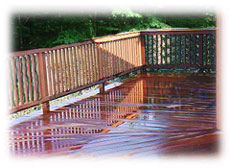Deck Pressure Washing
Unfortunately, all deck pressure washers are not created equal. The cheaper washers usually do not have enough power to do the adequate deck power washing. So, in order to try deck washing in different ways, people decide to use household bleach (sodium hypochlorite) as their brightening agent. Using a product with this ingredient on your deck can be a problem. If you do decide to use it, you will soon learn how hard the bleach is on the wood. The liquid will certainly take away the gray and will kill the mold spores, but at the same time it will mangle the wood fibers and leave a residue, which will keep stains and sealers from penetrating the wood properly.
The pressure you'll need for deck cleaning is 1500 pounds per square inch (PSI). Most deck restoration contractors recommend using cold water power washers in the 1500 to 1800 PSI range. Do not use a hot water pressure washer. The hot water will raise the grain severely. There are usually 4 nozzle tip sizes used for general power washing:
0º tip — Do not use for wood. The spray pattern is a concentrated straight stream that will damage wood.
15º tip — Use for tough cleaning jobs. Good for driveways, patios and concrete.
25º tip — Use for modest cleaning jobs. This is a good choice for deck powerwashing.
40º tip — Use for light cleaning jobs. Best for gutters, surfaces covered with leaves and sand, and general rinsing. We do not suggest using the rotating brush because the it can cause wood fiber hairs to lift and remain on the wood.There is a definite technique for pressure washing decks. If not done correctly, you can damage or scar wood. The best and easiest way to learn deck wash technique is to practice on old boards. The wand should always be kept in motion when it is close to the wood. Stopping the wand while still spraying water will scar the wood. To avoid scaring, arc the wand up and away from the surface at the end of each stroke. No matter what is on a deck, even if it is just plain dirty, you should use a cleaning solution. Using a cleaner allows you to use less pressure and also makes it easier to do a nice, even, consistent job cleaning it. Have a look at our excellent chemicals for the restoration of exterior wood surfaces including decks.
Caring for your deck by removing the graying, dirt, mold and mildew is an important part of protecting your investment. Wood needs 24 hours to dry after washing or being wet before applying sealant, and can be sealed the day after that. Pressure washing and sealing your home's other wooden items such as fences, gazebos, and playground equipment are equally important, as they face the same exposure. Following these simple instructions should teach you how to clean deck properly.
The publisher of these pages is in no way responsible for any damage caused to you, your pressure washer, anyone else, your property, or anyone else's property by trying to implement or by successfully implementing the above-mentioned performance and services.



